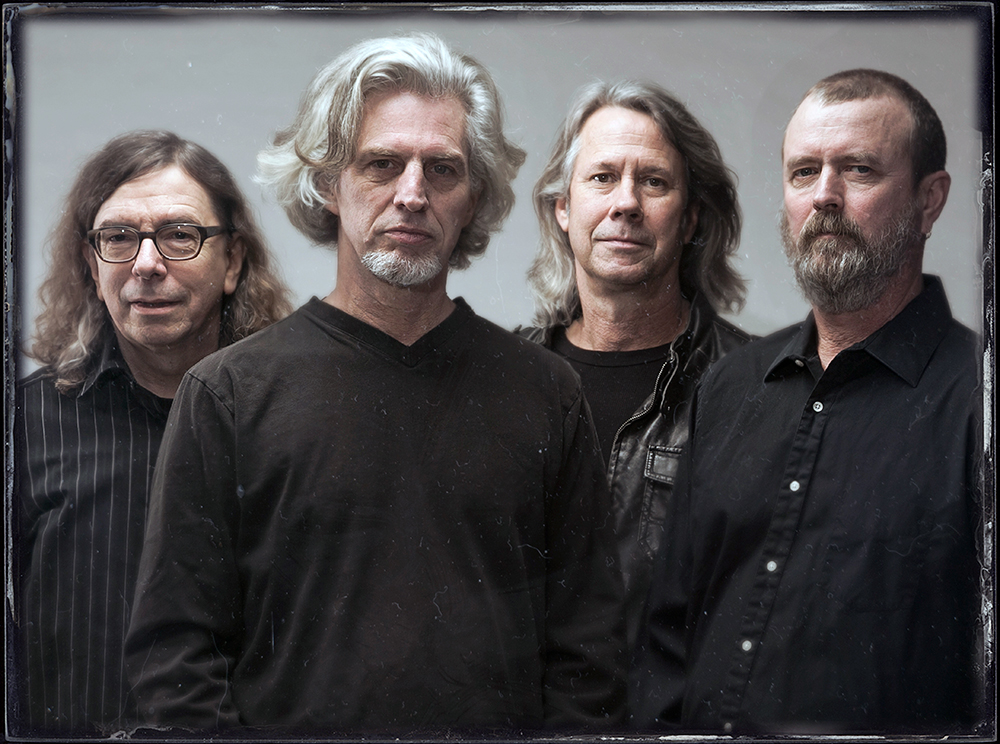 | Aural Fixation:The Art of the Album Cover |
 |
“Aural Fixation” is a music-themed column I wrote for PopMatters.com from 2011-2013. They are no longer online there, but I have reformatted them here at the DMDB blog with additional videos, photos, and links, such as where to buy referenced albums. I have also used the title “Aural Fixation” for any essays I have written outside of PopMatters.com as well. To see the essays, check out the Dave’s Music Database Aural Fixation page. You can also purchase the essays in book format here. |
Eons ago during my college days, I had a buddy named Don. We ended up as roommates down the line, but when we first became friends he was living with a guy named Tyrone. The two of them were pretty different. Their musical tastes pretty well summed it up – Don was a fan of Manhattan Transfer and Linda Ronstadt while I recall Ty listening to more hair bands and heavy metal. One afternoon I trekked up to the third floor of our dorm to visit Don. He wasn’t home. I hung out with Ty poring over his albums. And yes, I mean LPs – complete with large, square cardboard covers which could also properly house artwork on the front, back, and insides. We ended up rating his albums – not based on the music, but on the cover art. We devised categories, which I’ll recall here to the best of my ability. On a scale of 1 to 5, albums merely emblazoned with band logos and album names rated the worst (1). Bon Jovi’s Slippery When Wet is a prime example – especially when one considers that the originally planned cover (see here) was, while crude and sexist, at least more interesting to look at.
Dull band and artist photos which looked like publicity stills also got thumbs-down ratings (2). How many times can Phil Collins plaster his less-than-model-beautiful face on the front of an album? Garth Brooks may be one of the best-selling album artists in history, but are his fans clamoring for all his multi-platinum efforts to be splashed with uninspiring shots of him hiding his balding head with an ever-present cowboy hat? Couldn’t No Fences at least have been infused with a bit of humorous irony by having him pose against a fence?
In all fairness, these covers aren’t tragedies. They are just uninteresting. If you’re looking for the truly awful – covers that evoke gasps of disbelief or make you throw up in your mouth a little – there are sites devoted to just such endeavors. For covers like the one below, check out worstalbumcovers.org, coverbrowser.com, or this page at superdps.com.
To continue with the Ty-and-Dave rating system, a photo of a band done in at least some semi-interesting or amusing fashion garnered a passing grade (3 out of 5). Only the completely prudish would stifle a chuckle at the Who’s Next album cover.
Albums got kudos when they were bold enough to forego an image of the band altogether in favor of interesting photos or imagery (4) such as Pink Floyd’s Wish You Were Here.
Best of all were fully commissioned works of art which one would consider hanging on the wall (5). These were albums which made the buyer feel like they’d made a decent investment even if the music sucked. Roger Dean made a name for himself as the artist for Yes and Asia album covers.
A poll by MusicRadar.com forced me to revisit what makes for great album art. The Ty-and-Dave scale celebrated the effort put into a cover’s creation. However, upon surfing the Web for best-covers-of-all-time lists, my resulting aggregate DMDB list proved that an album falling anywhere on the scale could make the cut. Sadly, this diversity of album effort is largely predicated on the reality that to achieve classic album art status first requires attaining classic album status. While the idea of a classic collection of music housed in a classic exterior is appealing, the hope was that this list would turn up inspired works of album art, regardless of what was within. A full 39 of 100 albums on the best-covers list also make the DMDB’s list of the top 100 albums of all time. Of the 62 albums left, another 46 made the DMDB top 1000 albums list. This left a mere sixteen albums to boast of classic packaging that had nothing to do with what was tucked inside the cardboard. That means this list is populated with album covers that in some cases are more iconic than great. As the bestselling album of all-time, Michael Jackson’s Thriller is inescapable. It follows that the packaging for such an album would be roughly as recognizable to anyone who lived through the 1980s as would be a picture of President Ronald Reagan. However, that doesn’t mean the Thriller album cover is a great work of art. On the Ty-and-Dave scale, this thing is merely a promo photo, which would land it a miserable 2 on a scale of 5.
The Ty-and-Dave scale was frequently trumped with iconic imagery trumping effort. The Beatles’ White Album, Metallica’s Black Album, and AC/DC’s Back in Black made the list precisely because of their absence of artwork. Never Mind the Bollocks, Here’s the Sex Pistols would rate a 1 on the Ty-and-Dave scale, but its logo has become so iconic it lands the album in the top 10. Pink Floyd’s The Wall is nothing more than a brick wall with the title scrawled upon it, but it has become one of the most recognizable album covers of all time.
Simple band or artist photos of the Beatles (With the Beatles), Fleetwood Mac (Rumours), Bruce Springsteen (Born to Run), Prince (Purple Rain), Patti Smith (Horses), and the Ramones (self-titled debut) didn’t hamper them from making the cut.
The Beatles’ Abbey Road, Elvis Presley’s 50,000,000 Elvis Fans Can’t Be Wrong, David Bowie’s Aladdin Sane, U2’s The Joshua Tree, the Police’s Synchronicity, and N.W.A.’s Straight Outta Compton, all make the list with photos depicting them in more interesting ways than the standard band shots. Some of these images have reached iconic status, such as Annie Leibovitz’s twist on the shot of the artist with her photo’s focus of Bruce Springsteen’s butt on Born in the U.S.A.. The Queen II cover was immortalized when the group revisited the image in the video of “Bohemian Rhapsody” a couple albums later. It has practically become the still shot to represent the band.
Some albums stuck with depictions of the artists, but eschewed photography as the medium of choice. Guns N’ Roses’ Appetite for Destruction, the Beatles’ Revolver, Cream’s Disraeli Gears, the Rolling Stones’ Some Girls, Elton John’s Captain Fantastic and the Brown Dirt Cowboy, and Frank Sinatra’s In the Wee Small Hours all opted for this approach.
Upping the game a bit were those covers abandoning any reference to the artist in favor of representative photos. Supertramp’s Breakfast in America was a straightforward but clever interpretation of the album title while the Doors’ Strange Days captured a fittingly odd circus-on-the-sidewalk shot. The Rolling Stones generated controversy with their image of a toilet and its surrounding graffiti. New Order went with a beautiful picture of roses to contradict the Power, Corruption and Lies album title. Sometimes the image evoked puzzlement. What’s with the crab on the cover of the Prodigy’s Fat of the Land or the shot of the cow on Pink Floyd’s Atom Heart Mother? How about that odd sheep dog jumping a hurdle on Beck’s Odelay? At other times, the image was pretty straightforward. DJ Shadow’s Endtroducing was just a shot of browsers in a record store.
A whole subset of the non-band-photo technique emerged via the “provocative” cover (i.e., covers which featured nudity or came close). Roxy Music’s Country Life, the Cars’ Candy-O, the Pixies’ Surfer Rosa, and Bow Wow Wow’s roll-off-the-tongue title See Jungle! See Jungle! Go Join Your Gang, Yeah. City All Over! Go Ape Crazy! all gave horny teens drooling material. The latter was an homage to Edouard Manet’s 1863 painting “Le déjeuner sur l’herbe (The Lunch on the Grass),” but since Annabella Lwin was only 15 when photographed sans clothing, the album art had to be reworked in some markets.
Joy Division’s Unknown Pleasures, Primal Scream’s Screamadelica, Mike Oldfield’s Tubular Bells, and Velvet Underground’s debut all proved that simple imagery could make for impactful art. VU’s banana cover, created by famed pop artist Andy Warhol, has become one of the most iconic covers in music history.
Of course, the Velvet album was also notable for innovative packaging. Early versions of the album inticed the buyer to “peel slowly and see” – an invitation to see the flesh-colored banana beneath the banana skin. Warhol also conceived the Rolling Stones’ Sticky Fingers album cover, which featured a close-up of a blue-jeaned crotch and a working zipper. Unzipping it would show the inside of the album – a close-up of the model in briefs. Bob Marley’s original album for Catch a Fire was a picture of a Zippo lighter. One opened the album from the top, much as one would flip open a lighter. Public Image Ltd.’s Metal Box was originally packaged as three 12” 45 RPM’s in a metal canister.
The Band’s Music from Big Pink, the Stone Roses’ debut, Duran Duran’s Rio, Coldplay’s Viva La Vida, and King Crimson’s In the Court of the Crimson King (in all its disturbing glory) all went with paintings for their covers. Mati Klarwein, who painted the 1961 “Annunciation” (below) which served as the cover for Santana’s Abraxas, also lent his paintbrush to the classic cover for Miles Davis’ Bitches Brew.
On the lighter side, some albums used cartoons for their covers. Amongst the most prominent are Green Day’s Dookie, Big Brother and the Holding Company’s Cheap Thrills, the Mothers of Invention’s Weasels Ripped My Flesh, and Sonic Youth’s Goo.
Finally, there are some albums whose cover art has become as iconic as the albums they decorate. The naked baby swimming after a dollar on Nirvana’s Nevermind, the reworked version of Elvis Presley’s debut (itself an entry on the best-album-cover list) for the Clash’s London Calling, and the gathering of cardboard cut-out celebrities for the Beatles’ Sgt. Pepper’s Lonely Hearts Club Band all have entrenched themselves into pop culture. Topping them all, however, is the prism on Pink Floyd’s Dark Side of the Moon. That one would rate a 5 on the Ty-and-Dave scale.
For more “Aural Fixation” essays, check out the Dave’s Music Database Aural Fixation page page. Resources and Related Links:
First posted 4/26/2011; updated 10/27/2023. |
















